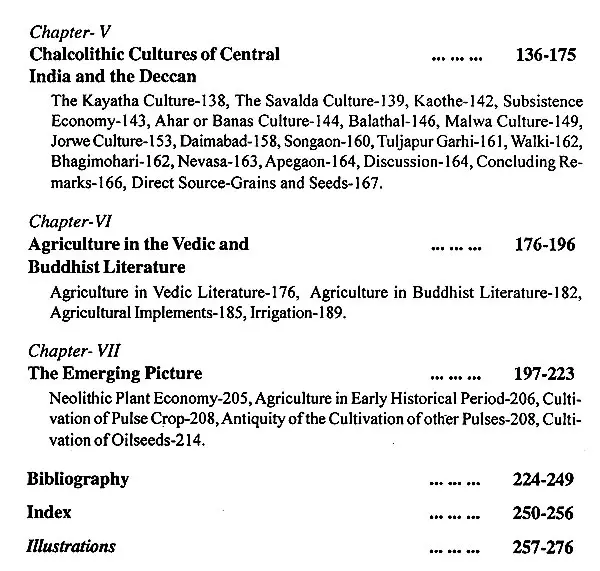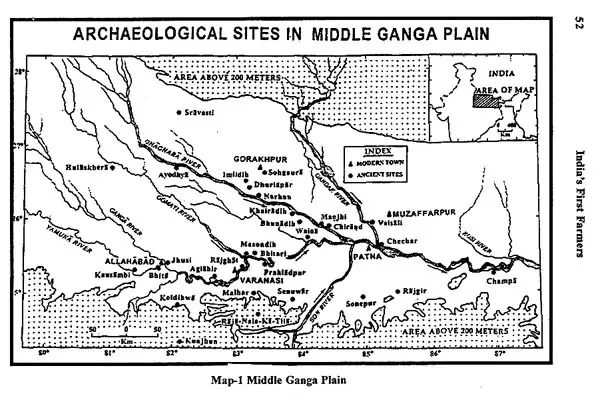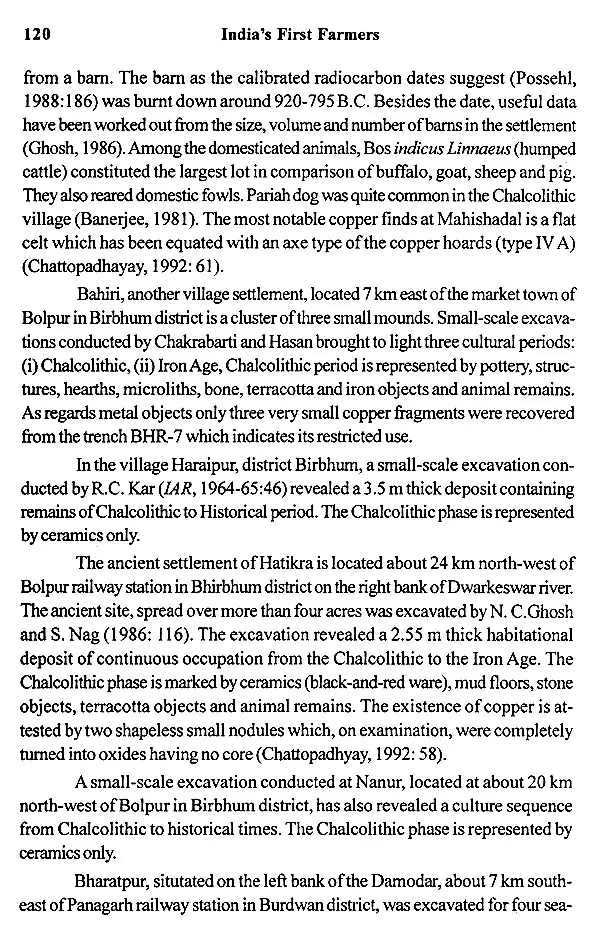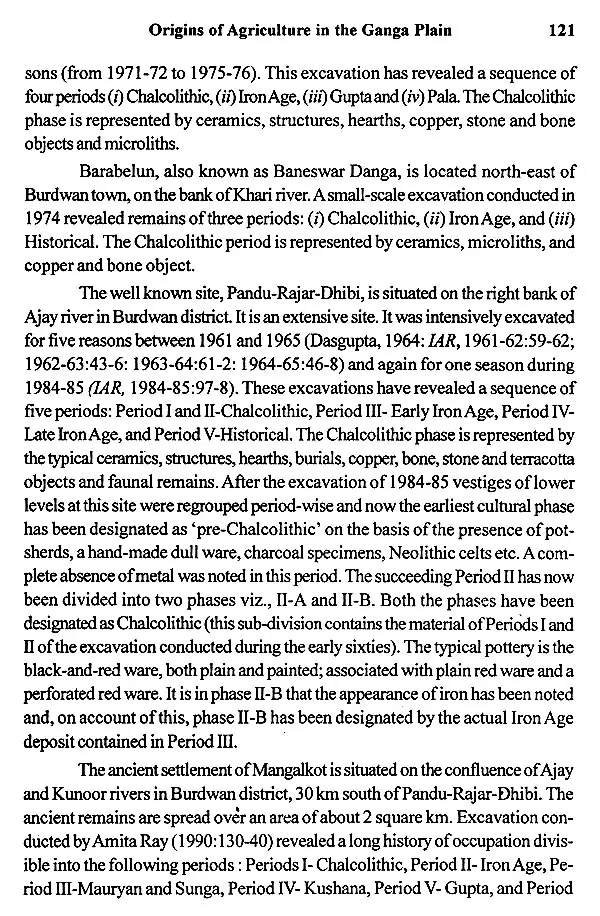
India's First Farmers
Book Specification
| Item Code: | UAG184 |
| Author: | Ranjit Pratap Singh |
| Publisher: | KALA PRAKASHAN |
| Language: | English |
| Edition: | 2010 |
| ISBN: | 9789380467313 |
| Pages: | 276 (Throughout B/W and Color Illustrations With 4 Maps) |
| Cover: | HARDCOVER |
| Other Details | 10.00 X 7.50 inch |
| Weight | 980 gm |
Book Description
The introduction of agriculture, around 10,000 years ago, brought about the greatest change in human life after the emergence of tool-making capability among the hominids some 2.5 million years ago. No other single event has so thoroughly transformed human life and society as the introduction of agriculture. Agriculture brought about permanently settled life and security of food and triggered the greatest demographic explosion in human history. With the availability of adequate and assured food supply more people could be fed. Secondly, agriculture created new occupations.
The present monograph reconstructs this fascinating story. It is based primarily on archaeobotanical evidences supported by archaeological and literary evidences. It encompasses the whole of Indo-Pakistan sub continent from the Neolithic period (seventh millennium B. C.) to the early historical period. The coherent story of the origin and spread of agriculture in India based primarily on archaeoBotanical evidences has been presented for the first time in this book.
Dr. Ranjit Pratap Singh is Assistant Professor in the department of AIHC & Archaeology, B.H.U., Varanasi. His field of specialization is Archaeology, Epigraphy and Numismatics. Earlier he has worked as Lecturer in Bajrang Degree College, Kunda, Pratapgarh and also in Mahatma Gandhi Kashi Vidyapith, Varanasi. He has been associated with the Department of AIHC & Archaeology, B.H.U. Is a Research Associate of the UGC and SAP Programme and also as Post Doctoral Fellow of the ICHR. He has participated in various national and international seminars and workshops and has contributed more than two dozen papers in reputed journals. His first book Agriculture in Protohistoric India, Pratibha Prakashan, Delhi 1990 was well received in the academic world.
This monograph is an updated version of the results of my research carried out in the Department of AIHC & Archaeology, Banaras Hindu University during the years 2003 2005. It takes note of all the relevant details on archaeobotany car out till today. This research was made possible through a post-doctoral fellowship provided by the ICHR, New Delhi. The author is thankful to the authorities of the ICHR for this financial help.
At the Banaras Hindu University, this research was carried out under the supervision of late Professor A. L. Yadava who could not see its completion because of his sudden and untimely death in December 2005. Professors Vidula Jayaswal and Vibha Tripathi, the successive Heads of the Department supported my research and rendered all administrative support. Professor Paras Nath Singh has provided all encouragement, but for which, its completion would have been difficult. I express my gratitude to all these three scholars. Thanks are also due to Prof. Sitaram Dubey, present Head of the Department of AIHC & Archaeology, B.H.U. and to Prof. Mohammad Naseem for their generous support and help. I am also thankful to my colleague Dr. R. N. Singh, who was always ready to take pain for my publication-related works and other activities. Academic help was unhesitatingly provided by Dr. K. S. Saraswat, Birbal Sahni Institute of Palacobotany, Lucknow and I shall always remain grateful to him. My friend Dr. Chandra Bhal Srivastava helped me in bringing this monograph to the present shape and I express my thanks to him. Prof. Parmanand Singh, Ex Head, Department of History, Mahatma Gandhi Kashi Vidyapeeth extended all support and I express my gratefulness to him.
This investigation would have been impossible without the evergreen encouragement and blessings of my father Dr. Purushottam Singh and mother late Smt. Champa Devi.
I am deeply indebted to my wife, Mrs. Nirmala Singh, whose care and support helped me to overcome many difficulties and depressions. I am also thankful to my sister Smt. Sagarika Singh for her warm encouragement and moral support.
The domestication of animals and cultivation of certain plants were great steps forward taken by mankind as these mark the beginning of mans' intervention with nature. So long as man was a hunter and food gatherer, he was a part of nature, like animals and birds. But once he invented agriculture and the art of domesticating animals, he was no longer a part of nature. With the beginning of cultivation of cereals man increased his control over environment, a process which is believed to have begun by 8000 BC (Moore, 1985: 232, Hillman et al. 1989:240).
The introduction of agriculture, around 10,000 years ago, brought about the greatest change in human life after the emergence of tool-making capability among the hominids some 2.5 million years ago. No other single event has so thoroughly transformed human life and society as the introduction of agriculture. First of all, agriculture brought about permanently settled life. Secondly, agriculture brought about security of food and triggered the greatest demographic explosion in human history. With the availability of adequate and assured food supply more people could be fed. Thirdly, agriculture created new occupations. With some farmers able to produce a surplus after meeting the needs of their own families, a section of the adult labour force could be freed from the task of food production and it could devote its talents and energies to new crafts. Thus, slowly new occupations like pottery making, brick making, bead making, carpentry, copper smelting and working, quarrying and dressing of stone for construction, etc. came into existence and the society became divided into different occupational groups (Misra, 2007: 152-53).
Scholars have tried to differentiate between the term 'cultivation' and 'domestication. Cultivation denotes the whole of mans' efforts to look after plants and in this sense it is quite possible to cultivate wild plants. Domestication involves genetic and accompanying morphological changes by which the plants become more suited to conditions of a man-made environment and less to those of a natural environment (Glover, 1979: 10).
CHANGING PARADIGMS
The domestication of plants and animals has been a topic of global interest and natural scientists and archaeologists in different parts of the world have been trying to understand this process. In this context mention may be made of the pioneering studies of Hans Helback, Jack Harlan, Daniel Zohary, Joseph Hutchinson, L. Costantini, T.T. Chang, Gordon C. Hillman, M.E. Kislev, W. Van Ziest, Maria Hopf and many others. So far as theoretical discussions on this topic are concerned, mention may be made of V. Gordon Childe, Mark Nathan Cohen, Barbara Bender, Sonia Cole, Philip E. L. Smith, Peter Ucko, W.B. Dimbleby, David R. Harris, Jack Golson, Kent V. Flannery, L.R. Binford, Peter Bellwood and many others.Presently a vigorous debate is raging as to the origins of agriculture and crop domestication. Not only does the question arise of when and where a particular crop was first domesticated but also of how and why. The root causes of the development of an agricultural economy have now become one of the archaeologists' main concerns though until quite recently such questions were largely ignored. In this connection mention may be made of three related hypotheses proposed to explain the shift from foraging to farming. The first is through climatic change, changes in sea-level, increased competition from other species, or similar causes, the naturally available food resources diminished and it became necessary to supplement them by growing food plants and domesticating animals. V. Gordon Childe was the foremost proponent of the view that the development of food production in the Near East was the result of desiccation' following the retreat of the ice sheets of the last glacial. He envisaged the focused concentration of human, animal and plant populations in the river valleys and around oases as leading to domestication and the adoption of food-producing economy, but he did not suggest what precise processes of adoption might have been involved in the establishment of this new mode of subsistence. Childe's hypothesis has been challenged on the grounds that no clear archaeological evidence exists for major post-glacial climatic changes in the Near East.
**Contents and Sample Pages**




















